Murano: a guide of the island and the art of glass
Index:
- The island of Murano: geographical position and territory
- How to get to Murano: connections with Venice and ferries
- Murano glass: what it is and how it is produced
- Tour in the workshops of glass artisans
- The art of glass: the main handcrafted glass products
- How to verify the authenticity of a Murano glass product?
- Murano: what to go and see?
- Where to stay in Murano?
Murano is one of the best-known islands of the Venice Lagoon, famous all over the world for the refined art of glass making. This small island of 5000 inhabitants, many of them direct descendants of famous families of glassmakers, is rich in culture and tradition and is certainly a place to consider for lovers of art and crafts or simply for the breath-taking views of the Venice lagoon. Then don’t miss the opportunity to visit Murano during your stay at Camping Ca’Savio: this island offers a lot to see!
The island of Murano: geographical position and territory
The island of Murano is located in the Veneto region (Italy), a short distance from beach side town Jesolo and Cavallino and lies to the north east of Venice, and has one of the most populated centres of the Venetian Lagoon.
The seven islands on which Murano is build are located along the Marani canal. They are crossed by canals and connected to each other by numerous bridges, just like in Venice.
The island of convents, Sacca Mattia, San Donato, Navagero, Sacca Serenella, San Pietro, San Stefano are the names of the seven islands.
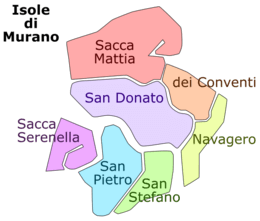
How to get to Murano: connections with Venice and ferries
The island of Murano, located in the Northern Venetian Lagoon, is only 10 minutes by vaporetto from the historic center of Venice and can be easily reached from Camping Ca’Savio by public transport. Starting from Treporti, a boarding area located about ten minutes from the campsite, you will be able to take a vaporetto every 30 minutes. Line 12 of public transport (ACTV company) provides a connection between the main islands of the lagoon: Burano, Torcello, Murano and Venice. It will take about 40 minutes to reach the island of Murano, in which you can enjoy the experience of sailing through the unique and breathtaking landscapes typical of the lagoon area.
If, on the other hand, you want to reach Murano starting from Venice, you have to go to Fondamenta Nuove and take line 12, 13, 4.1 or 4.2.
The single ticket costs € 7.50 (valid for 75 minutes), the day ticket costs € 20 (valid for 24 hours) and provides free circulation. Children 0-5 years do not pay for the ticket.
Tickets for the Venice AVM / Actv navigation network can be purchased through the following sales channels:
- Venezia Unica sales points in the historic center of Venice and on the mainland
- authorized dealers
- automatic ticket machines in the main arrival terminals and landing places of the AVM / Actv public transport
- Official AVM Venice App
- online at www.veneziaunica.it
- on board the means of navigation.
In addition to the option of public transport, you can choose to reach the island through guided tours organized by private agencies. Available almost every day and diversified in the offer, there are tours that make a sightseeing tour of Burano and Murano. The departure of the tours is available from both Punta Sabbioni and Treporti, depending on the tour selected. The main agencies that offer this service are Marco Polo and Il Doge, departing from Punta Sabbioni, and Turistica Penzo, which departs from Treporti (near the center of Ca’Savio).
Another option to reach the island of Murano is the Venetiana Hop-on Hop-off service, which provides for the presence of two “lines”: one that goes around the islands of Burano, Murano and Torcello; one that instead includes a more internal tour of Venice with stops within the city (Santa Lucia, Tronchetto, San Marco, Zattere). The line of islands departs from Punta Sabbioni, boarding located 4 km from Camping Ca’Savio. Both lines, that of the islands and that of Venice, share a stop in Murano.
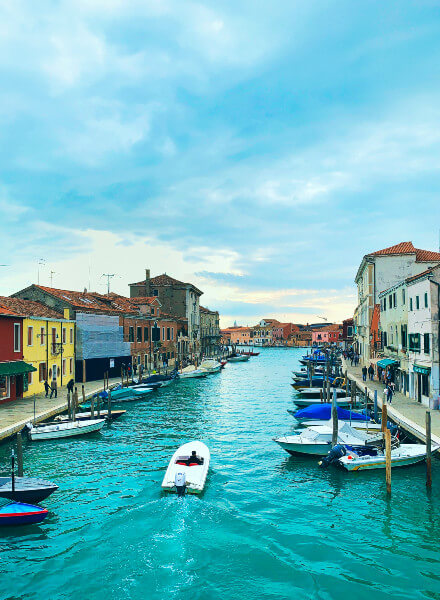
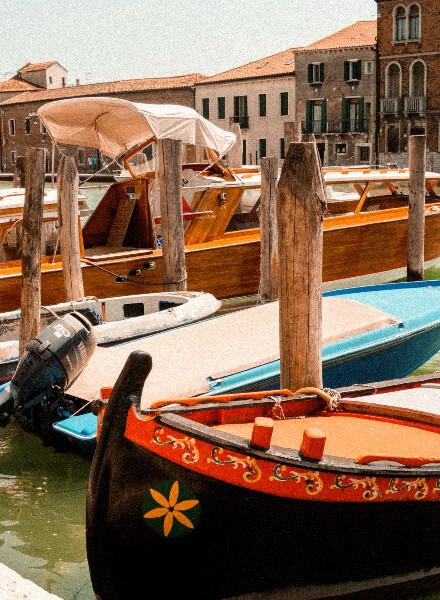
Murano glass: what it is and how it is produced
The main raw material for glass production is silica sand, along with soda and limestone. By heating these three elements inside ovens that reach a temperature of over 1300° C, the ingredients will melt and mix to obtain molten, liquid glass. Once cooled, it will form the transparent, ductile and brittle material we know: glass.
When the glass is still warm and therefore soft, it can be worked with various techniques to produce different shapes and objects. During processing, the craftsman can add other chemicals to make the glass opaque, eliminate bubbles, or color the glass.
There are two main techniques for working Murano glass: blowing and lampworking.
In the case of blowing, the craftsman takes the necessary amount of glass paste, still hot and incandescent, with the end of the blow pipe. The air is then blown into the barrel, to produce a swelling of the glass sphere. At the same time he rotates the material and, with the help of pliers and scissors, shapes the object he wishes to obtain. Subsequently, when the glass paste cools and solidifies, the still unfinished object is heated in the furnace, in order to complete the processing.
Lampworking is one of the most used techniques currently for the creation of glass jewels, pendants and precious pearls, but also for the creation of small animal figurines. Lampworking is a very ancient technique: it was based on a lamp used as a heat source to work glass. Today the lamp has been replaced by a metal torch connected to a propane or methane gas cylinder, capable of directing a fiery beam on the glass. The semi-finished product, once incandescent, can be modeled with various tools and movements until the desired shape is obtained.
The set of these countless techniques is handed down from generation to generation and reinvented by every single craftsman or artist. Visiting the workshops scattered among the streets and foundations of Murano will undoubtedly give you an idea of the ancient mastery and the magic of each master’s creative contribution.
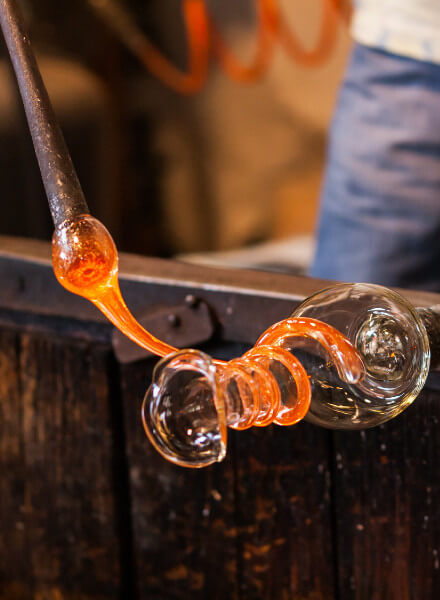
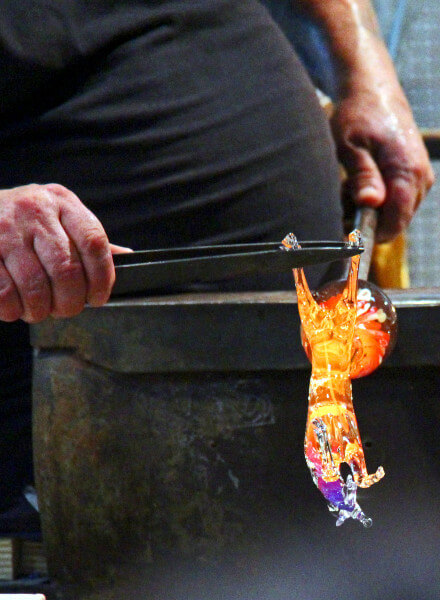
Tour in the workshops of glass artisans
Our suggestion is to visit one of the many furnaces before visiting the other places of interest such as, for example, the Glass Museum, in order to better appreciate the glass working technique and understand its historical and artistic importance. .
Some furnaces not only carry out demonstrations, but even allow you to independently experiment with glass processing. Remember that glass processing involves the use of ovens, so if you are planning a visit in June or July (most of these are closed in August), we recommend that you dress lightly.
Among the glassworks that can be visited and which often also include workshops:
- The furnace of the Emmedue Artistic Glass Factory is open to the public every day from 9.00 to 16.30. From Monday to Friday, it is possible to watch the production of Venetian-style glasses from the 15th to the 18th century, while on Saturdays and Sundays there are demonstrations. Emmedue’s staff is prepared to talk about glass processing in Murano from its origins to the present day in Italian, English, French, Spanish, Russian and German.
- The Gino Mazzuccato glassworks is operational every day of the week and sees glass masters with decades of experience working together, helpers and a kiln manager, who coordinates the work of the staff. All products are created using the ancient techniques of glassmaking, preserving the tradition. The furnace is easily reachable by public transport (Vaporetto line 4.1, Murano Colonna stop) as it is the first structure you come across when arriving on the island of Murano.
Other glassworks that also carry out laboratories are the Guarnieri Glass Factory, the Fornace Mian, the Vetreria Artistica Colleoni, the glassworks Mazzega and the Vetreria Artistica Ferro e Lazzarini.
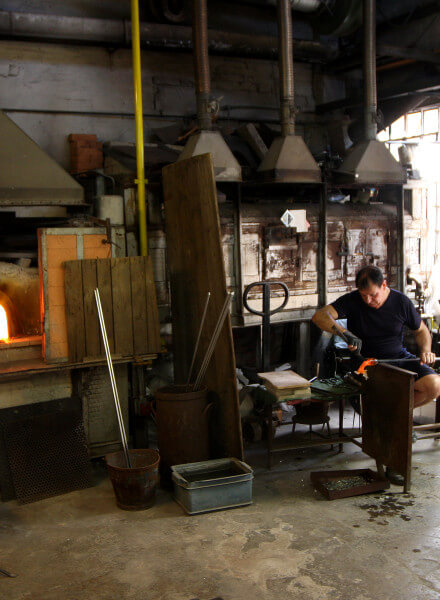
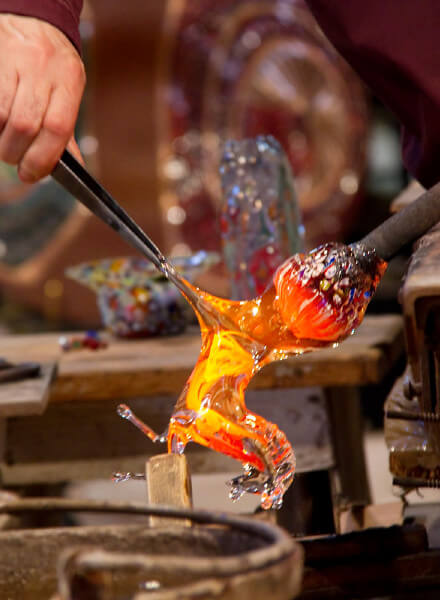
The art of glass: the main handcrafted glass products
The variety of glass products made in Murano is truly impressive: you will find everyday objects such as paperweights or letter openers, but also plates, vases and jewels up to home accessories and much more.
- The sculptures made of Murano glass demonstrate how wide the possibilities are to shape this material. Using the wire technique, glass masters can work out the smallest details. Animals, plants, people and abstract shapes are the most common subjects.
- The production of mirrors has a long tradition in Murano. The special recipe for making mirrors was kept secret for a long time: Murano mirrors became a luxury item that only aristocratic families could afford. Their decorations still make Murano mirrors very coveted collectibles today.
- Many artists make Murano glass glasses; some pieces are considered valuable works of art that reach high prices on the market. Carlo Moretti is one of the best-known contemporary Murano glass artists.
- Murano glass vases are particularly precious. The design of shape, pattern, technology and color makes each vase a unique piece.
- The classic Murano glass chandeliers involve a very complex and small-scale production and are therefore quite expensive. The classic style is rather decorated and precious, but there are several lines that also range towards a modern design.
- Murano glass jewelry is very popular on the island. In addition to rings, earrings, necklaces and bracelets, the so-called “beads” are also made of Murano glass. The millefiori murrina, obtained from a particularly complex process, is particularly appreciated, especially in recent years.
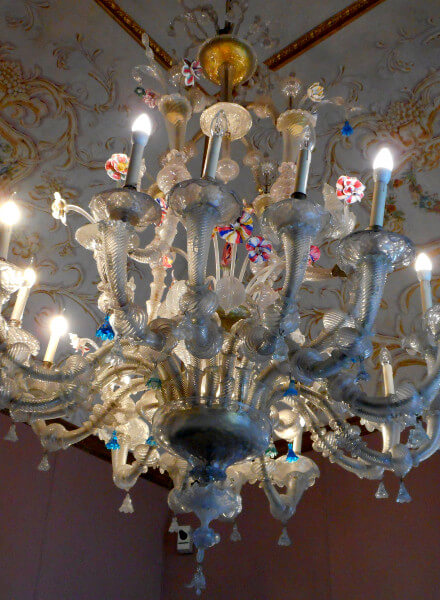
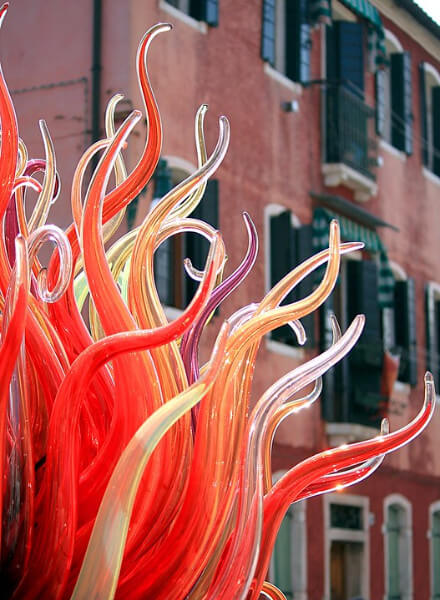
How to verify the authenticity of a Murano glass product?
The experience and the observation of the details allow to recognize the authenticity of a Murano glass product: the stylistic research, the quality of the workmanship, the brilliance of the colors and the lightness of these artifacts are elements that allow to evaluate the authenticity. Even some small imperfections represent a distinctive sign, precisely because these products are handmade.
However, there are many counterfeit products, so it is advisable to be wary of unrecognized headings, such as “Murano glass product” or “Murano glass product” and instead choose products that are accompanied by the guarantee certificate and the “Vetro Artistico® Murano” sticker. , a collective brand established by the Veneto Region, which certifies that the products are made on the island of Murano. More information on http://www.muranoglass.com
Murano: what to go and see?
Murano is one of the closest islands and easily reachable from the historic centre of Venice and is worth a visit not only for the glassworks and furnaces, but also for other important attractions, such as the Glass Museum (which can also be visited with the Museum pass), the Basilica of Santa Maria and San Donato, Palazzo Da Mula, the Church of San Pietro Martire, the lighthouse, the Grand Canal of Murano.
Here is some information on the main attractions of Murano.
The Glass Museum
Located in a seventeenth-century palace in a flowery Gothic style, the museum offers a path that crosses centuries of glass history, from the Roman finds of the archaeological section to the first medieval Venetian finds, from the crystalline glass of the fifteenth century to the Renaissance filigree, from the birth of the chandeliers from the Briati factory to the grandiose eighteenth-century mirrors, up to the contemporary design creations.
The Basilica of Santa Maria and San Donato
Dating back to the 7th century, the Basilica of Santa Maria and San Donato is the Cathedral of the island of Murano, one of the most important examples of Romanesque in the lagoon. While many churches contain the bones of the saints, this basilica contains something more than just the relic of San Donato. Behind the altar are in fact suspended four ribs, more than 1 meter long, which according to legend came from a dragon killed by San Donato in Greece. The Cathedral, made of brick and marble, also has a very rich mosaic floor in marble and polychrome glass, dating back to around 1140, which greatly influenced the artistic production of the time (in particular the similar artefacts of the Pomposa Abbey). In the church you can also find one of the oldest painted panels by the Venetian.
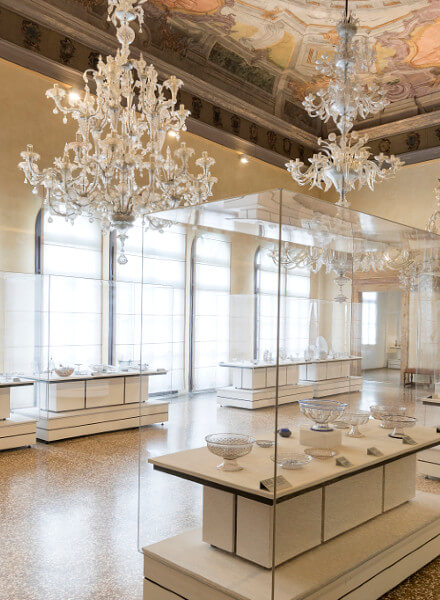
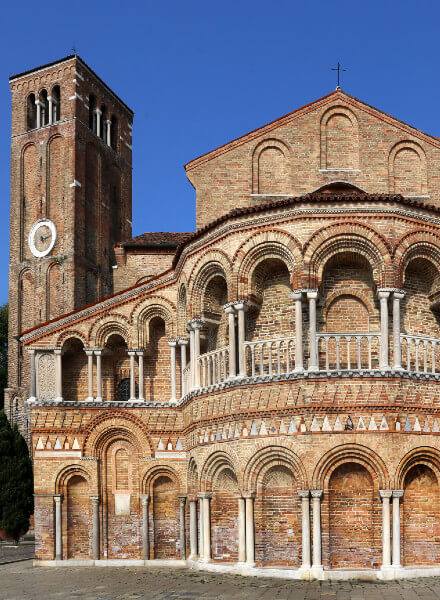
Palazzo da Mula
This palace, the luxurious summer residence of the Venetian Da Mula family, is one of the last remaining examples of Venetian Gothic architecture. It is a marvellous building dating back to the Renaissance which maintains the splendid façade almost unchanged, with Venetian-Byzantine decorations of considerable artistic interest. The Palace is located in the central part of the island and can be easily reached on foot from the Murano Faro stop.
Church of San Pietro Martire
Located in Campo Santo Stefano, the largest square in Murano, the Church of San Pietro Martire was built in 1506 and presents some peculiar aspects of Renaissance art. Inside you can admire very important paintings by Tintoretto, Bellini and Veronese. The church can be reached in a few minutes on foot from the Murano ACTV stops.
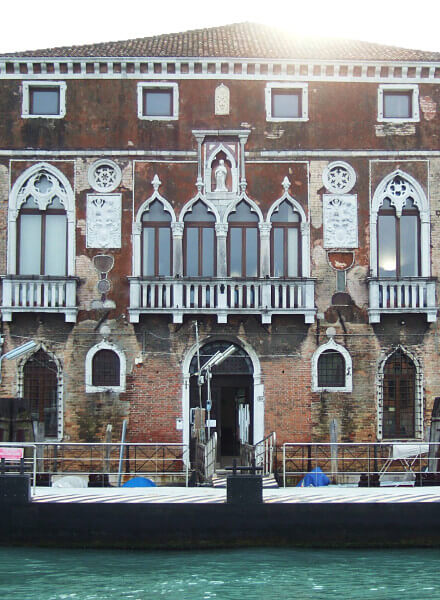
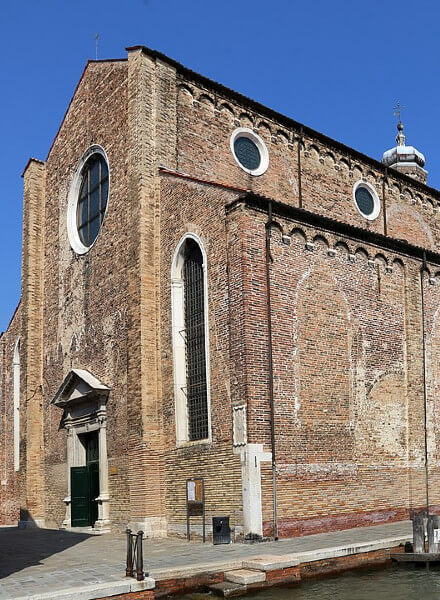
The Murano lighthouse
There has been a lighthouse on the island of Murano since the time of the Serenissima. At that time it consisted of a simple wooden tower on the top of which fires were lit to illuminate the lagoon and during the day it served as a lookout. The white lighthouse of Murano as we know it today dates back to 1934 and is a distinctive landmark of the island.
The Grand Canal
Like Venice, Murano also has its Grand Canal which divides the city into two parts. Here the Grand Canal is crossed by the Vivarini Bridge – called by the residents “Ponte Lungo”. Along the course of the Grand Canal of Murano you can see the entrances of numerous glassworks and furnaces, the bell tower of Santa Maria and San Donato, the bell tower of San Pietro Martire, the Palazzo da Mula.
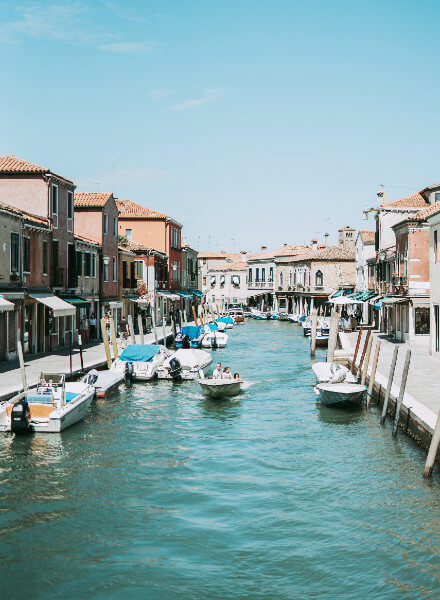
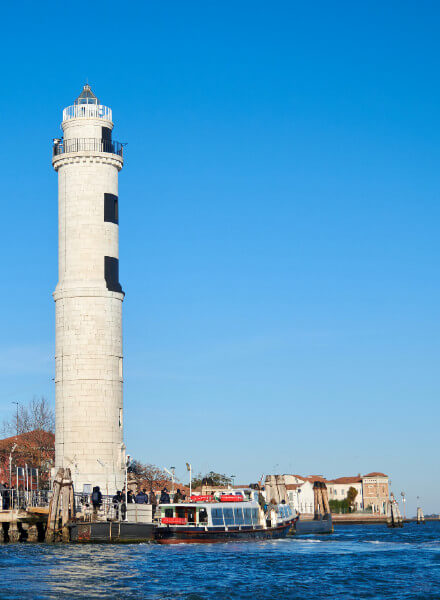
Where to stay in Murano?
Staying in Murano in one of the hotels or bed and breakfasts on the island certainly represents a quieter solution than in the historic center of Venice.
An alternative could be to stay in a campsite on the Cavallino coast, in order to combine a visit to Venice and the island of Murano with a pleasant beach holiday. Camping Ca ‘Savio, which overlooks a kilometer of beach, is 10 minutes from the landing stage and from the ferries to Venice and the islands of the lagoon, including Murano. If you want to see current offers, consult this page.
